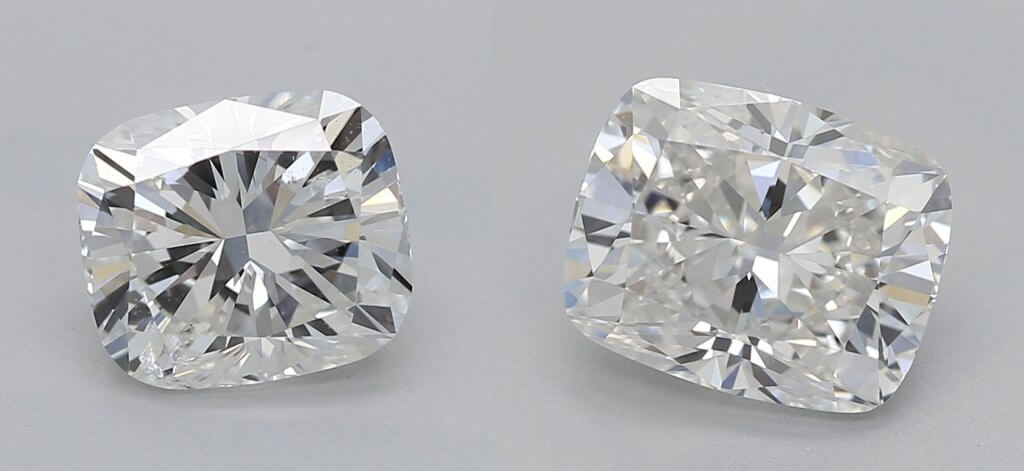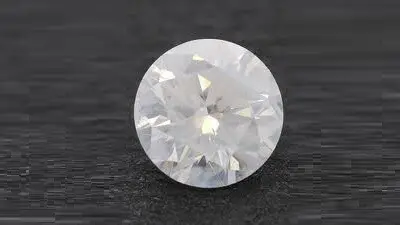SI1 Versus SI2 Clarity – Who Wins?

By Gary A.

Edited by Olivia H.
Published Jul 28, 2022
Edited on Dec 17, 2024
When it comes to choosing between SI1 and SI2 clarity for your diamond engagement ring, understanding the subtle differences can help you find the perfect balance between beauty and value.

- 7 Quick Tips for Examining Clarity in SI1 vs SI2 Diamond Engagement Rings
- Introduction
- Deep Dive into SI1 and SI2 Clarity
- Our Expert Take
- 10 FAQs
Before we dive deeper into the specifics, here are some practical tips to help guide your decision-making process:
7 Quick Tips for Examining Clarity in SI1 vs SI2 Diamond Engagement Rings
When purchasing a diamond engagement ring, particularly when considering the clarity grades SI1 and SI2, there are specific aspects you should pay attention to. These tips will help you make an informed choice and understand the subtle differences between these two clarity grades.
- Tip 1:Understand the Visibility of Inclusions: SI1 diamonds typically have inclusions that are visible under 10x magnification but are usually not visible to the naked eye. SI2 diamonds may have inclusions that are more easily visible, and sometimes these can be spotted without magnification. Carefully inspect the diamond to see if you can identify any inclusions with your unaided eye.
- Tip 2:Examine the Location and Type of Inclusions: Inclusions near the edges of the diamond are less likely to be noticeable and can often be hidden by the setting of the ring. Inclusions in the center or under the table of the diamond are more visible and can impact the stone’s appearance more significantly.
- Tip 3:Consider the Impact of Diamond Cut: A high-quality cut can enhance the brilliance and sparkle of the diamond, which can make inclusions less noticeable. Round, princess, and other brilliant-cut diamonds tend to hide inclusions better than step-cut stones like emeralds or asschers.
- Tip 4:Assess the Diamond’s Size: The larger the diamond, the more likely inclusions are to be visible. When comparing SI1 and SI2 diamonds of larger carat sizes, pay extra attention to the clarity as inclusions might be more apparent.
- Tip 5:Be Mindful of Diamond Shape: Certain diamond shapes can hide inclusions more effectively than others. For example, round and oval cuts can mask inclusions better compared to emerald cuts. Consider the diamond shape in relation to the clarity grade when making your decision.
- Tip 6:Look for Symmetry and Overall Appearance: A well-symmetrical diamond, regardless of SI1 or SI2 clarity, will have a better overall appearance. Ensure that the diamond is pleasing to your eye in terms of symmetry, as this can also influence how inclusions are perceived.
- Tip 7:Pay Attention to Diamond Color: The color of the diamond can influence the visibility of inclusions. Inclusions in a diamond with a higher color grade (closer to colorless) can be more noticeable. A slight tint in the diamond might help mask some inclusions, so consider this factor when choosing between SI1 and SI2.
Now that you’ve got these practical tips, use Jeweler AI below to find the perfect engagement ring that suits your style and budget:
Introduction
The GIA’s clarity scale comprises many incremental changes in quality, which means that the differences between one grade and the next are very subtle – and, as we mentioned before, barely noticeable to anyone who is not very well educated in the world of diamonds and geology.
By now, you’ve probably wrapped your head around the idea that, by dipping from VS2 to SI1, you’re unlikely to be able to detect any difference in quality, since SI1 is still a very popular grade for finding eye clean diamonds – but can you go lower?
Absolutely. There are real and tangible differences between diamonds graded at SI1 and SI2 but, as you can see from the clarity scale, the two grades are categorized under one definition: inclusions that are noticeable at 10x magnification and, sometimes, also without magnification.
Remember that, as with any clarity grade, it’s never an exact science. No two SI2 diamonds are the same, and some will be incredible investments while others won’t be. The SI1 grade sits on the boundary between grades that are abundant in eye clean diamonds, and grades that offer more non-eye clean options than eye clean options.
While the SI grades are great for bagging a deal, you can’t be sure you’re getting a good deal unless you are shopping from a reputable source. Unlike many other online sellers, we have a resident diamond expert on-hand to check each diamond for quality and beauty – something that proves pivotal to our customers.
Deep Dive into SI1 and SI2 Clarity
The differences are subtle and open to interpretation, but the key difference between SI1 and SI2 diamonds is the extent and visibility of the inclusions.
SI1 vs SI2: A Detailed Comparison
There’s no exact mathematic formula or ‘master diamond’ to set the example of how SI1 and SI2 diamonds should be sorted. If each diamond’s inclusions had to follow a very specific pattern in order to fit with a particular grade, then there would have to be as many clarity grades as there are diamonds in the world, since every diamond is totally unique – like a fingerprint.
In SI1 diamonds, inclusions are noticeable under 10x magnification but, in SI2 diamonds, inclusions are more easily noticeable under 10x magnification, without being so severe and so obvious that the stone ought to be considered I1, I2, or I3.
If there was no ‘intermediary’ grade between SI1 and I1, then many diamonds with fairly noticeable inclusions (under magnification) would have to be sold as SI1, which means a higher price for slightly lower quality – or, alternatively, they would have to be marketed as I1 and, as a result, sold at a lower value than they could realistically attain.
Funnily enough, this is the argument some labs – like the EGL – use in favor of the SI3 clarity grade, which has proven pretty controversial since its introduction. SI3, however, is not a grade we consider to be beneficial to shoppers – and, since the GIA does not consider it a true clarity grade, we would advise any of our readers to avoid it.
Analyzing Pricing and Value
The biggest benefit to purchasing an SI2 diamond over an SI1 diamond is the fact that you’ll get a more attractive price. An SI2 diamond will generally work out to be between 10% and 30% cheaper than a comparable SI1 diamond, but you won’t want to take advantage of the very top end of those savings, since the cheapest SI2 diamonds are unlikely to be eye clean, or worth the money.
If you find an SI2 diamond that appears eye clean (and checks all the boxes for Cut quality and Color, as well as other aspects like proportion, ratio, and fluorescence) then saving a few hundred dollars on Clarity is an excellent decision.
If, however, you find an SI2 diamond that is not eye clean – or, alternatively, that is eye clean but fails to live up to your standards for Cut, Color, or any other aspect of quality – then it won’t represent a worthwhile investment, and should be left behind in favor of a better diamond at a similar price point.

Ultimately, there is no simple, one-word answer to the SI1 vs SI2 debate, just as there’s no straightforward answer to the question of VS2 vs SI1. It’s all about what you’re willing to pay for, and what you’re not. While you’re not an expert on the subject, you don’t need to be – you just need to understand what you’re looking for, and what you’re willing to pay for.
The Influence of Cut and Color
Color doesn’t mask inclusions, so don’t worry too much about compensating for a lower clarity grade with a higher color grade. An I Color SI2 diamond can look stunning and, for all intents and purposes, flawless too.
Cut is more important. The brilliant and modified brilliant cuts like the Round, Cushion, and Radiant are a lot more effective at hiding minor inclusions than an Emerald or Asscher, both of which feature more open, elongated facets that make for easier viewing of small flaws.
This means that, if you’re looking for an Emerald cut diamond, you’ll probably want to focus a little higher on the clarity scale – say, SI1 or VS2, or VS1 if your diamond is on the larger side.
Our Expert Take
SI1 and SI2 are two of the very best clarity grades for finding good deals on beautiful diamonds. There is no shortage of eye clean diamonds at both of these clarity grades, so don’t shy away just because they’re lower on the scale.
Keep in mind the impact that diamond shape has on eye cleanliness and visual quality. Step cut diamonds are more likely to reveal their minor flaws than brilliant cut diamonds, so don’t go too far down the clarity scale if you’re looking at a step cut.
10 FAQs
- Q: What does SI1 mean in diamond grading?
A: SI1 stands for ‘Slightly Included 1’, indicating that the diamond contains minor inclusions visible under 10x magnification but typically not visible to the naked eye. - Q: Are SI1 diamonds eye-clean?
A: Most SI1 diamonds are considered eye-clean, meaning their inclusions are not visible when viewed with the naked eye. - Q: How does the price of SI1 diamonds compare to higher clarity grades?
A: SI1 diamonds are generally more affordable than higher clarity grades like VS1 or VVS1, offering a good balance of quality and value. - Q: Is SI1 a good clarity for an engagement ring?
A: Yes, SI1 is a popular choice for engagement rings as it provides a good balance between clarity, appearance, and cost. - Q: Can you tell the difference between SI1 and VS1 diamonds with the naked eye?
A: In most cases, the differences between SI1 and VS1 clarity grades are not visible to the naked eye, especially in smaller diamonds. - Q: Should I consider a lab-grown SI1 diamond?
A: Lab-grown SI1 diamonds are a bad choice. Lab-grown are traded in 95% less than a natural diamond. Buy only flawless lab grown if you go in to lab grown. - Q: How important is the cut quality of an SI1 diamond?
A: The cut quality is crucial for any diamond, including SI1, as it greatly influences the diamond’s brilliance and overall appearance. - Q: Do SI1 diamonds hold their value over time?
A: Like all diamonds, SI1 diamonds can maintain or appreciate in value depending on market conditions, rarity, and other factors. - Q: Are there any specific settings recommended for SI1 diamonds?
A: SI1 diamonds can be set in a variety of styles. However, settings like the halo or bezel can provide additional protection and enhance the diamond’s appearance. - Q: How can I ensure I’m getting a good quality SI1 diamond?
A: Always purchase diamonds from reputable dealers with certification, ideally from the GIA, and consider an expert evaluation if possible.
Explore the world of diamonds with Jeweler AI‘s precision. Dive into SI1 vs SI2 clarity and make your perfect choice with confidence!
FOLLOW-UP GUIDE SERIES





















